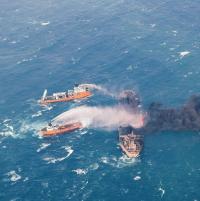
Tanker Sanchi on fire, shortly before sinking
On January 6th, the Iranian tanker Sanchi carrying 130,000 tonnes of condensate collided with the Chinese bulk carrier CF Crystal. The condensate on the Sanchi caught fire, resulting in the death of all 32 of the tanker’s crew. The tanker burned for 9 days before sinking after a series of explosions. Initial concerns were that the oil slick might reach the Japanese coast. An official from the Japanese environmental ministry told Reuters that the oil slick is being carried north by an ocean current and is unlikely to hit the coast of Japan.
Rick Steiner, a marine conservation specialist formerly with the University of Alaska, told the Associated Press that 60,000 to 90,000 tons was likely to have spilled into the sea, calling it “enormous” and “as large as the official estimate of the Exxon Valdez disaster” off the coast of Alaska in 1989. He also suggested that the Chinese government was likely to be understating the magnitude of the spill.
How serious is a major condensate spill? It is difficult to say. This may be the largest condensate spill in history. There is no baseline for comparison. The only good news is that the cargo on the Sanchi is very different from the heavy crude oil on the Exxon Valdez. The condensate carried on the Sanchi is a liquid, usually a byproduct of natural gas production, formed by a variety of gases which condense when extracted. Unlike crude oil, the liquid is often clear and odorless. Condensate is usually composed of propane, butane, pentane or hexane but can also contain impurities such as carbon dioxide, hydrogen sulfide, aromatics, and naphthenes.
The heavy crude oil from the Exxon Valdez contained high levels of tar. The residual tar and oil on the shoreline of Prince William Sound remain to this day, more than 25 years after the spill, despite billions spent in attempted cleanup. While the chemicals which make up condensate are all highly toxic, they do evaporate and disperse.
The Japanese Coast Guard has reported that after initially growing larger, the condensate slicks appear to have begun to shrink.

i think the cargo of the was naphta, which is a kind of condensate, very light
and high explosive. you cant even pump it only with a low discharge rate.
hope this will explain a bit.
ex esso